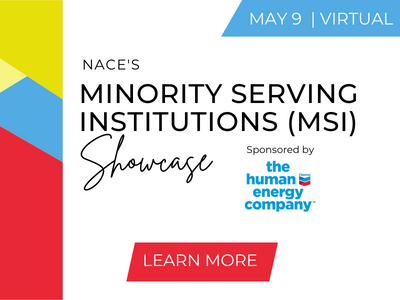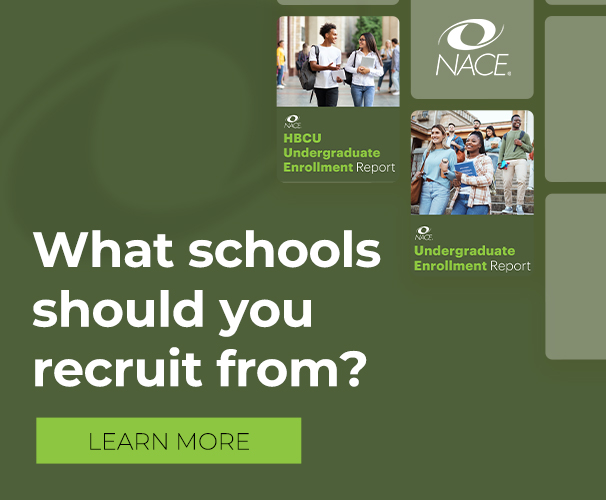Spotlight for Career Services Professionals
Spotlight for Recruiting Professionals
The word “fit” is frequently used in the college recruiting field, often to describe the match between a new college graduate and the culture of an organization. “Fit” is a term, however, that Tierney Bates would like to see removed from the field’s vernacular.
“I would like to eliminate the word ‘fit’ for the simple fact that America is based on Eurocentric ideals, so there was never room for growth or opportunity for people of color or people of different backgrounds to be truly embraced with the word ‘fit,’” says Bates, interim executive director of university career services at the University of North Carolina at Chapel Hill (UNC), who is black.
“As I walk into an organization or I walk into an institution, I must fit this assimilation process, but it is not necessarily willing to take all of me.”
Bates says that language is a key element of diversity, equity, and inclusion (DEI), and can help or hinder efforts in this area.
“Equity is where this gets lost because when an organization recruits, when it hires, when it says that its organizational culture is about fit, it really should be about the candidate and its needs,” he explains.
“What organizations should be saying to me is that they do want to hire persons of color, they do want to hire people who are different, and they are going to be more adamant about it. However, when they say ‘fit,’ they start excluding because, although I may meet the criteria of their job description, they ultimately tend to hire based on this ‘fit.’”
This discrepancy between language and action came into play recently when Bates reviewed the website of a company that touted its commitment to diversity. He looked at its mission and vision, and how it addressed diversity, equity, and inclusion. They are saying the right things.
“However, when I looked at its leadership team, there were 16 people, but none of them were people of color and only a few were white females,” he says.
“Of course, I cannot say whether or not they were not LGBTQ, but from the perspectives of women or people of color, the language they used to detail their commitment to DEI was not reflected in their leadership. Would a person of color truly fit the culture there? Would a woman have equal opportunities to advance to leadership roles? These are the questions students ask. There needs to be accountability for the language they use.”
Bates says that for career centers and URR functions involved with DEI, language should be a top priority.
“How they use language defines who they are and their commitment to supporting, hiring, and helping communities of color, members of their multi-generational work force, and others who may face challenges in the job search or workplace,” he explains.
“Language should be addressed regularly in staff meetings and meetings with leadership. Language should be agreed upon and shared within the group and the office or organization. It should be used to show their values. This is important to students seeking the help of the career center and as students determine the organizations they want to join.”
They should also deeply examine the meaning of the words they use. Bates points out that career centers and organizations use the term “diversity” very loosely.
“It is an easy word for them to use,” he adds.
“It is visible and it feels good to say ‘We are diverse’ or ‘We support diversity.’ However, ‘equity’ is much more imposing. Equity means you are righting wrongs and is the number one thing they don’t get right, by, for example, hiring more women or people of color.”
Bates listens to and looks at the ways career centers and employers use language.
“The first thing I do when I walk through the door of a career center or organization is to listen for some kind of shared language that is spoken or see if it is up on the walls,” he says.
“This is what students look for, too. For those who work there, the language or artwork may just blend in because it is familiar. For students, however, this language—both spoken and implied—is an important factor as they determine if they want to work with career services offices or for employers.”
Bates, himself, identifies as “black” instead of “African-American.” He also recognizes that this is not the case for everyone who is black.
“This is why conversations around language are so important,” he notes.
“Offices and organizations should ask their employees what they prefer.”
Engaging employees in this process also leads to greater understanding. For example, Bates says dialogue around organization-wide language to support and accommodate transgender people is important to gain an understanding of what a transgender person coming into the company may encounter, and to make them feel comfortable and that they are a valuable part of the team.
“I also believe that we need to think more about intersectionality,” he continues.
“For instance, a student can be transgender, Latino, and identify as a woman. We have to consider these intersections when trying to attract students into our career centers and organizations, and supporting them once they are there. A new hire can walk through an organization’s door and become part of three or four different employee resource groups.”
Bates offers some additional recommendations for career centers and URR functions for using language to support their DEI efforts:
- Use the word “spouse” or “partner” when someone is asked or wearing a wedding band, rather than assuming the person is married to someone of the opposite sex.
- Ask students for preferred pronouns. Do not assume.
- Have a standardized set of questions you ask all advisees that relate to identity (i.e. is there an element of your identity that you feel will affect how you go about the job search?).
- Develop educational programming around job searching as a person of color/queer person and what the latest research demonstrates about the barriers they may face.
- Contextualize the pay gap for women and directly address how it looks different for women of color.
- Use language that places the “person first.” (For more information, see www.counseling.org/resources/library/vistas/2011-v-online/Article_05.pdf.)
- Do not use the term “minorities,” but rather use “communities of color” or “students of color.”
- Take the extra time took for the ways students use language in cover letters and resumes for evidence that they are members of diverse groups. This might be revealed in the organizations the students is a member of or awards the student has won. Doing so can help organizations build pools of diverse candidates.
- Do not make assumptions. For example, Bates says that he frequently receives correspondence that starts “Dear Miss Bates” because of his first name. “[The sender has not] Googled me or looked for a picture,” he says. “I chuckle about it, but students might not. Making assumptions might get things off to a bad start.”
“Using language to attract and retain students is very important to effective DEI efforts,” Bates says.
“The goal is to combine that language with accountability to create a welcoming environment that those who are ‘different’ will want to become a part of and where they will have the opportunities to search for or build a career.”






